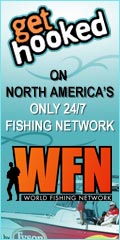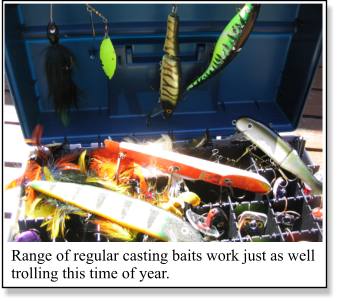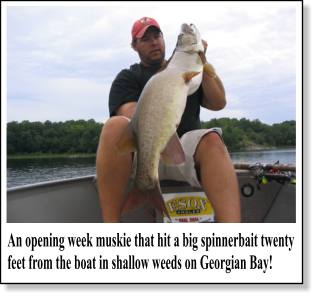
Click Here

I am very pleased to announce that Kyla Tooley from Espanola is the
winner of our Extreme Angler - Muskie Print!!

Congrats again, and a very BIG thank you to Karl at Extreme Angler TV
www.extremeanglertv.com for supplying such a generous
prize!!
Editors & Publishers
T.J. & Monique Quesnel
The
Ontario Fishing Network
E-Magazine is
published 12 times a year on or near the beginning of every month. Our
magazine is geared to any angler who enjoys fishing of any type in the
wonderfully diverse province of Ontario.
Editorial Submissions: We welcome query letters,
but assume no responsibility for unsolicited materials.
Subscriptions: Subscriptions are FREE of charge
and delivered via email. You can subscribe
HERE:
Privacy Policy: Unlike other publications We
NEVER make our subscribers list (your email address) available to any
other companies.
Advertising: If you are interested in advertising
please email us.
Circulation - 7,500 email subscribers
© 2007 Due North
Marketing / Ontario Fishing Network / T.J. Quesnel. All rights
reserved. Reproduction of any material without prior written
permission strictly prohibited.
|
Opening Day Muskie: You Can Troll, Too!
By J.P. Bushey
 Trolling
isn't just a fall technique for muskie. During the entire season, no
matter what month it is, some spots are laid out for casting, some
for trolling and some for both. Early in the summer, all species
have a lot of options. Food production is ramping up to seasonal
highs. Surface temps are leveling out, and weeds are gaining their
green, healthy momentum. Spots aren't normally overrun with grass,
and good cabbage or coontail will be popping up in the best spots.
For the most part, those big, sloppy bands and walls of mixed weed
haven't formed yet. If you cast, targets might be less common than
they are by mid-summer, but they're easier to identify and fish. If
you troll, getting your boat and baits through is easier than later
in the summer, too. Trolling
isn't just a fall technique for muskie. During the entire season, no
matter what month it is, some spots are laid out for casting, some
for trolling and some for both. Early in the summer, all species
have a lot of options. Food production is ramping up to seasonal
highs. Surface temps are leveling out, and weeds are gaining their
green, healthy momentum. Spots aren't normally overrun with grass,
and good cabbage or coontail will be popping up in the best spots.
For the most part, those big, sloppy bands and walls of mixed weed
haven't formed yet. If you cast, targets might be less common than
they are by mid-summer, but they're easier to identify and fish. If
you troll, getting your boat and baits through is easier than later
in the summer, too.
Trolling in late June and the first half of July is a viable option
on any kind of water. The theory is that muskies are beginning to
leave spawning areas and use 'home range' type areas for the balance
of the summer. Fish that are migrating in any way-leaving a spawning
site for a home range feature, or wandering between separate home
range features-are catchable. I have no clue when or why fish travel
day to day, but I'm 100% certain that they do. A nice part of the
deal is that your casting baits can be used for trolling at this
time of year.
There isn't much point in trying to lay out specifics for all of the
scenarios that you'll encounter. Lakes and rivers are different,
fish populations are different, and no two Opening Days seem to be
the same. But trolling is a highly adaptable way of fishing, and you
can have success with it on a range of water bodies, areas and
set-ups.
Fishing right in shallow water and setting baits to run shallow over
deeper water are two good, basic approaches. Over deeper water, the
surface down to about fifteen or twenty feet is normally the focal
point. On shallower spots, muskies can be caught in as little as
three or four feet of water. In bays or larger coves where weeds are
starting over soft bottom, you can keep baits close to the boat and
really pick through the newer patches. Spinnerbaits are consistently
one of the most effective year in and year out. They're great for
weed contact and have good presence in open water between weeds with
lots of vibration. It's amazing how much cleaner single hooks stay
versus trebles. Baits tied with tandem 5/0 to 9/0 singles are great
here. Nearly all of my spinnerbaits, regardless of their
application, have single hooks. Bucktail, marabou or rubber skirts
all work.
 Surface
lures and jerkbaits are also very effective in shallow water.
Neither are exactly common choices for trolling, but they can be
highly effective. 'Pump trolling' Suicks or Bobbie Baits just
outside the prop wash or further away from the boat is hard work,
but the fish love it some days. You're basically working the lure
with pulls and sweeps from a standing position near the back of the
boat. With the rod tip low, the retrieve is just like you would use
casting, the bait just stays in the water the entire time. The same
rigging you'd use for casting jerkbaits works well for trolling
them. Eater-sized pike and walleyes jump all over this one, too.
Weighted models work best, and bending the tail fin down helps the
lure get down a few extra feet and stay there when you troll it. It
can add wobble to these lures, too. Baits like Sledges can be
straight-trolled close to the prop wash by pinning them in position
with a half pound to one pound lead weight above the leader. If you
own a Sledge, check its action over the side of the boat at 3 to 5
miles per hour next time out, you'll like it. Surface
lures and jerkbaits are also very effective in shallow water.
Neither are exactly common choices for trolling, but they can be
highly effective. 'Pump trolling' Suicks or Bobbie Baits just
outside the prop wash or further away from the boat is hard work,
but the fish love it some days. You're basically working the lure
with pulls and sweeps from a standing position near the back of the
boat. With the rod tip low, the retrieve is just like you would use
casting, the bait just stays in the water the entire time. The same
rigging you'd use for casting jerkbaits works well for trolling
them. Eater-sized pike and walleyes jump all over this one, too.
Weighted models work best, and bending the tail fin down helps the
lure get down a few extra feet and stay there when you troll it. It
can add wobble to these lures, too. Baits like Sledges can be
straight-trolled close to the prop wash by pinning them in position
with a half pound to one pound lead weight above the leader. If you
own a Sledge, check its action over the side of the boat at 3 to 5
miles per hour next time out, you'll like it.
Surface baits are something I'm just getting into for trolling, but
guys have been having success with them for years. You have the
option of sending one away from the boat on a short lead behind a
small trolling board or working them much closer. Loud,
straight-running baits that don't tangle and hook well are the most
common. Some fishermen will even bulge big spinnerbaits tight to the
boat. I can't wait to see a thirty pounder take a surface lure
close-range like that! Of course, surface lures stay above trouble,
also. Most weeds haven't quite reached the surface at this time most
years.
Like we've all had drilled into our heads, any kind of oddity along
a trolling run is worth checking, maybe even returning and casting
to. Rock piles, deep/open spots in between the weeds and the shore,
between weed patches or any other feature can attract a fish. Some
days, muskies in shallow water will be stuck right on cover or
structure, other times they're out wandering around. If some of your
favorite early-season areas are large and you can safely get your
boat through them, trolling is a great way to check them fast. Even
if you can't get a strike trolling, you'll get a good snapshot of
weed growth and forage in locations that you can explore slower,
later on. There are bays on the French River and Lake Nipissing that
take hours to troll properly. Casting eats a lot more time.
Shallow, shallow, shallow, cast, cast, cast certainly works early
on. But I can tell you that there are nice fish traversing open
water at the same time. These travel zones might simply be a few
cast lengths off a shallow run in the same bays or channels, or they
can be way out, over much deeper, more 'sterile' looking water.
The shortest distance between any two points on a map is a straight
line. If an appealing spot to a muskie is across a 1000 yard span of
open water and it wants to get there, do you think it will swim all
the way around the shoreline? That shoreline might take her several
kilometers out of the way. She's going to cross the open water. They
absolutely will follow drop-offs and shoreline/structure-related
routes when it suits, but on big water especially, open crossings
are often the more efficient option of the two. And in a lot of
cases, some of the prime eating can be done out there. I'm a firm
believer that on trophy-caliber water, there exists small
populations of big fish that rarely, if ever, leave open water.
They're not the reproductive machines they once were and simply get
by eating and hunting. (Now that's the life!) I'm anything but a
biologist, but my belief has been that the really huge ones do less
and less of the spawning thing the older they get. This could easily
be proven false.
Baits like Jakes, Believers, Grandmas and Outkasts are great in more
open water. You still don't need to run them real deep, and smaller
baits behind planer boards make sense here, too. They'll hit a range
of lures, as long as they come through at a depth and speed where
muskies can find them. The best bait is still the one in the right
zone. I think it's like fishing 'out there' at any other time of the
year: you're better off a little higher than a little lower. Of
course, banging any rocks at the right depths anywhere they pop up
along open runs can pay, too. Big shoals or shallow features out in
'no mans land' hold fish early, too. Open water areas are another
situation where I'm going to try trolling surface baits,
particularly at and after dark. Big, pounding spinnerbaits have the
right combination of attraction and hooking power.
I'm just like anyone else. After a long off-season, I'm dying to get
out and start chucking lures, especially any of the new ones I've
made, modified or bought over the winter. Shallow water is almost
always where I like to check first, if for no other reason than to
see weed growth, temps and what food's around. It isn't uncommon to
see and catch muskies in shallower water and then over or around the
open areas in the same day. They'll use both types of areas. It
blows my mind watching boats roar out of one area, only to come off
plane and start all over again a short distance away. I troll
between 'em. I'm positive muskies don't jump up on shore and jog
from area to area. If the next best area is down the shoreline
further, I'll zig zag along that path. If it's across a piece of
open water, I'll swing the boat that way and fish my way across it.
There's normally at least five rod holders on my boat all year, set
at differing angles and positions. Some are low to the water and set
back on angles for short-line trolling. Some are off the gunnels at
90 degrees for long rods and a wide spread in open water. At least
one is set high, for pulling small trolling boards with lures like
spinnerbaits, Shallow Invaders or Super Shad Raps.
You can troll in a lot of different ways and in a lot of different
spots early on. Many years, it's been a hot producer. Hearing that
first clicker squawk of the summer gets me as charged up as feeling
any casting strike. At the very least, even if you're 'not a troller,'
just try keeping lures wet traveling between spots a few times this
Opener. You might be surprised what happens. If you've finished
casting an area and it's large enough to troll, try a pass or two
before blasting off.
|